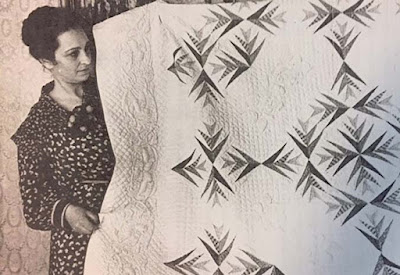Bertha Sheramsky Stenge (1891-1957)
About 1935
When Bertha Sheramsky was 18 and living with her parents and older (half-?) brother in Alameda, California, the census taker recorded her as an "artist" with her "own studio."
Alameda in the East Bay near San Francisco about 1930.
A 1955 interview on her art training.
Bertha Sheramsky Stenge (1891-1957)
Time/Life photographer Myron Davis
photographed the artist at work in 1946.
She'd also enjoyed mention in Newsweek.
Bertha chose a Century of Progress in architecture with
the dismissive image of the "teepees" of the Indigenous settlers on
Lake Michigan as the primitive and the "Temples" of modern architecture
as the ultimate in progress.
At 6:00 in her circular design, teepees up through Chicago's history to fair buildings at 12.
Contestants found out about the contest in January and entries were due in the middle of May.
Collection of the Chicago Historical Society
That spring Bertha put a good deal of quilting into her entry with some
echoes of traditional piecing.
Thousands of quilters entered; no one won the grand prize promised for a commemorative quilt.
The winner was a traditional quilt, entered
by a needlework shop owner who commissioned the star quilt.
The judges must have been impressed with the
stuffed work quilting, an almost forgotten art.
Sketch of the prizewinner with stuffed work or trapunto
quilted leaves.
Many quilters copied the winner using patterns and kits.
Bertha Stenge was impressed with the stuffed quilting herself. Merikay Waldvogel tells us Bertha "heard it was the trapunto quilting on the grand prizewinning quilt that caught the judges’ eyes. Sooo she learned a short cut and added trapunto quilting designs to her quilt entries from then on."
"Here she is shown with her Hosannah Palm quilt (1935). It won in the Trapunto Class of the 1935 Kentucky State Fair. She also entered it in a 1936 Grange Quilt Contest and then again in the 1940 New York World’s Fair contest America Through the Needle’s Eye” where the quilt won first prize.
Two years later she entered the Woman’s Day National Needlework Exhibition
with her Victory Quilt and won the $1000 grand prize.
Victory Quilt
Art Institute of Chicago Collection
She and Bernard went to New York to pick up the check at Madison Square Garden in November, 1942.
Illinois State Museum Collection
Detail of the stuffed work quilting in Iva's Pincushion, 1936
Collection of the Briscoe Center of American History
Rachel's Wreath, 1935























No comments:
Post a Comment